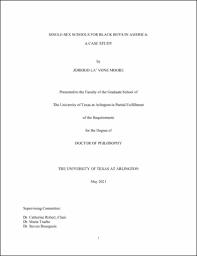
ATTENTION: The works hosted here are being migrated to a new repository that will consolidate resources, improve discoverability, and better show UTA's research impact on the global community. We will update authors as the migration progresses. Please see MavMatrix for more information.
Show simple item record
| dc.contributor.advisor | Robert , Catherine | |
| dc.creator | Moore, Jorriod | |
| dc.date.accessioned | 2021-06-02T21:34:21Z | |
| dc.date.available | 2021-06-02T21:34:21Z | |
| dc.date.created | 2021-05 | |
| dc.date.issued | 2021-04-30 | |
| dc.date.submitted | May 2021 | |
| dc.identifier.uri | http://hdl.handle.net/10106/29851 | |
| dc.description.abstract | The underperformance of Black boys attending public schools in the United States of America is a concern among parents and communities who believe that coeducational schools (CE) are failing to meet the learning needs of Black boys. Despite coeducational schools' best efforts to employ and support teachers' professional growth, the achievement gap continues to widen for Black boys. As a result, they are more likely to drop out of school and are less likely to go to college than their female peers, limiting their chances of escaping poverty.
This case-study examines teachers' and principals' perceptions of an all-boys, single-sex schools and their ability to meet the learning needs of Black boys on their campus. Fergus and Noguera’s two theories for single-sex schools for boys of color (Black and Latino boys) frame this analysis: a) single-sex schools understand and know the social and emotional needs of Black and Latino boys, and b) single-sex schools understand how Black and Latino boys' academic needs have emerged and focus on strategies to address those needs. The research was conducted at an all-boys middle to high school in North Texas that primarily served Black and Latino boys.
The findings reveal that teachers and principals have positive attitudes toward the all-boys, single-sex school and believe they are successful at meeting the social-emotional and academic needs of Black boys on their campus. Teachers and principals consider the single-sex school to be a safe learning environment for Black boys, citing their ability to cultivate a shared mindset among the staff, foster a culture of competition and brotherhood among the boys, and establish a boy-centered instructional environment as critical aspects of their overall success. This case study concludes with a list of best practices, recommendations for future research, and policy implications for an all-boys, single-sex school. | |
| dc.format.mimetype | application/pdf | |
| dc.language.iso | en_US | |
| dc.subject | Urban | |
| dc.subject | Single-sex school | |
| dc.subject | Black boys | |
| dc.title | SINGLE-SEX SCHOOLS FOR BLACK BOYS IN AMERICA: A CASE STUDY | |
| dc.type | Thesis | |
| dc.degree.department | Educational Leadership and Policy Studies | |
| dc.degree.name | Doctor of Philosophy in Educational Leadership and Policy Studies | |
| dc.date.updated | 2021-06-02T21:34:22Z | |
| thesis.degree.department | Educational Leadership and Policy Studies | |
| thesis.degree.grantor | The University of Texas at Arlington | |
| thesis.degree.level | Doctoral | |
| thesis.degree.name | Doctor of Philosophy in Educational Leadership and Policy Studies | |
| dc.type.material | text | |
| dc.creator.orcid | 0000-0002-7532-008X | |
Files in this item
- Name:
- MOORE-DISSERTATION-2021.pdf
- Size:
- 2.135Mb
- Format:
- PDF
This item appears in the following Collection(s)
Show simple item record


